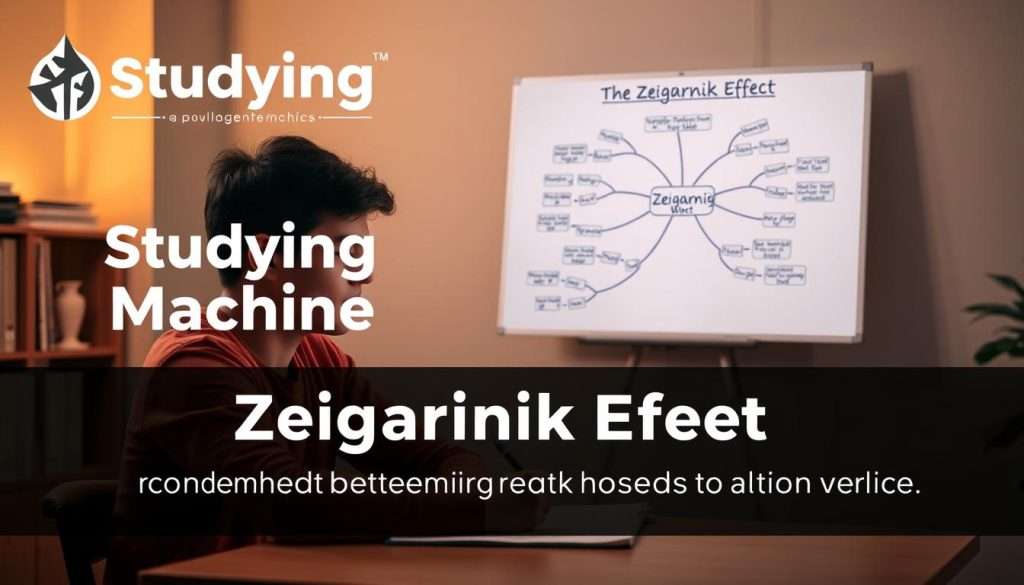Have you ever found yourself preoccupied with an unfinished task, unable to shake it off your mind? This phenomenon is rooted in a fascinating psychological concept known as the Zeigarnik Effect. It’s a trick that can help improve your memory by leveraging the brain’s tendency to recall unfinished tasks more effectively than completed ones.
The Zeigarnik Effect is named after the psychologist who discovered it. It suggests that our brains are wired to remember tasks that are left unfinished. By understanding and applying this psychological trick, you can potentially enhance your ability to recall important information.
Key Takeaways
- Understand the psychological basis of the Zeigarnik Effect.
- Learn how to apply the Zeigarnik Effect to improve memory.
- Discover the benefits of using this psychology trick in daily life.
- Explore the science behind why unfinished tasks are remembered better.
- Find out how to harness the power of the Zeigarnik Effect for better recall.
What Is the Zeigarnik Effect?
Bluma Zeigarnik’s accidental discovery in the early 20th century unveiled a powerful psychological effect that bears her name. The Zeigarnik Effect is a phenomenon where the human brain tends to remember uncompleted tasks or unresolved situations more effectively than completed ones.
The Accidental Discovery by Bluma Zeigarnik
Bluma Zeigarnik, a Russian psychologist, discovered this effect while studying under Kurt Lewin. Her observation was triggered by a simple yet profound incident involving a waiter who remembered outstanding orders but forgot them once they were paid for. This led Zeigarnik to investigate how our brains handle unfinished tasks.
Definition in Simple Terms
The Zeigarnik Effect can be defined as the cognitive tension or mental stress that occurs when we are unable to complete a task or resolve a situation. This tension enhances our memory of the task, making it more likely that we will recall it.
| Key Aspect | Description |
|---|---|
| Cognitive Tension | Mental stress caused by uncompleted tasks |
| Memory Enhancement | Better recall of unfinished tasks |
| Psychological Impact | Influences behavior and task persistence |
In simple terms, the Zeigarnik Effect explains why we often can’t stop thinking about tasks we’ve left undone. It’s a powerful psychological tool that can be harnessed to improve memory and productivity.
The Science Behind Unfinished Business
Our brains are constantly processing information, and the Zeigarnik Effect is a manifestation of this complex processing, particularly with regards to incomplete tasks. This phenomenon is not just a quirk of human psychology; it’s rooted in the brain’s fundamental processes.
How Your Brain Processes Incomplete Tasks
When faced with an incomplete task, our brain creates a mental representation of it, often referred to as an “open loop.” This open loop remains active until the task is completed, consuming mental resources and causing a sense of cognitive tension. This tension is the driving force behind our tendency to remember unfinished tasks better than completed ones.
The brain’s processing of incomplete tasks involves a network of regions, including those associated with working memory, attention, and emotional regulation. When a task is initiated, it creates a cognitive load that persists until the task is completed or abandoned.
The Cognitive Tension of Open Loops
The cognitive tension generated by open loops is a key factor in the Zeigarnik Effect. This tension arises from the brain’s discomfort with unfinished business, prompting it to allocate resources to resolve the task. The tension can manifest as intrusive thoughts or a nagging feeling that something needs to be done.
Open loops can be both beneficial and detrimental. On one hand, they can enhance productivity by motivating us to complete tasks. On the other hand, excessive open loops can lead to cognitive overload, decreasing our ability to focus and process information effectively.
Neurological Basis for the Effect
Research into the neurological basis of the Zeigarnik Effect has identified several brain regions involved, including the prefrontal cortex, which is responsible for working memory and decision-making, and the anterior cingulate cortex, which is associated with conflict monitoring and error detection.
The neurological underpinnings of the Zeigarnik Effect highlight the complex interplay between different brain regions in managing incomplete tasks. Understanding this can provide insights into how to harness the effect for improved productivity and memory.
Why Your Brain Obsesses Over Incomplete Tasks
Incomplete tasks can become an all-consuming force in our minds, driven by ancient survival instincts. This phenomenon is not just a quirk of modern life; it’s deeply rooted in our brain’s evolution.
Evolutionary Advantages
The Zeigarnik Effect has its roots in our ancestors’ need to remember crucial tasks for survival. Unfinished business, such as finding food or shelter, was a matter of life and death. This trait helped our ancestors stay focused on tasks that were essential to their survival.
The Psychology of Closure
Our brains are wired to seek closure, a concept closely related to the Zeigarnik Effect. When we don’t achieve closure, our minds keep the task open, mentally replaying it until we find a resolution. This psychological tension drives us to complete tasks.
Task Persistence and Survival
Task persistence was crucial for survival in our evolutionary past. The ability to stick with a task until completion meant the difference between life and death. This persistence is still valuable today, helping us achieve our goals in both personal and professional contexts.
| Aspect | Description | Benefit |
|---|---|---|
| Evolutionary Advantage | Remembering unfinished tasks for survival | Increased chances of survival |
| Psychology of Closure | Seeking resolution to mental tension | Reduced mental stress |
| Task Persistence | Completing tasks for survival and goals | Achievement of goals |
As we navigate our daily lives, understanding the Zeigarnik Effect can help us harness its power. By recognizing how our brains respond to incomplete tasks, we can better manage our mental resources and improve our productivity.
The Zeigarnik Effect in Everyday Life
Our daily lives are filled with examples of the Zeigarnik Effect, from binge-watching TV series to the constant checking of social media notifications. This psychological phenomenon influences our behaviors and thoughts in various subtle yet significant ways.
That Song Stuck in Your Head
Have you ever found yourself humming a tune that seems to be stuck on repeat? This is a classic example of the Zeigarnik Effect in action. The brain’s tendency to remember unfinished or unresolved elements can manifest as earworms, where a song or melody gets stuck in your head.
TV Cliffhangers and Binge-Watching
TV shows often use cliffhangers to keep viewers engaged, leveraging the Zeigarnik Effect to create a sense of cognitive tension. This tension motivates viewers to continue watching to resolve the unfinished storylines, leading to binge-watching behaviors.
Why You Can’t Stop Thinking About That Email
Unfinished tasks or unresolved communications, like an unanswered email, can occupy your thoughts. The Zeigarnik Effect explains why you might find yourself constantly thinking about responding or checking for a reply, as your brain tries to close the loop on the task.
Social Media and Notification Addiction
The constant checking of social media notifications is another manifestation of the Zeigarnik Effect. Each notification can be seen as an open loop, prompting you to check and respond, thereby creating a cycle of addiction to the instant gratification of resolving these digital interactions.
Recognizing the Zeigarnik Effect in these daily experiences can help you understand the underlying psychological forces driving your behaviors and thoughts. By being aware of these influences, you can take steps to manage them more effectively.
How the Zeigarnik Effect Boosts Your Memory
Cognitive tension, as explained by the Zeigarnik Effect, plays a crucial role in boosting memory retention. When we’re faced with an incomplete task or an unresolved situation, our brains create a mental tension that seeks resolution. This tension enhances our ability to remember details related to the task or situation.
Memory Formation and Retention
The Zeigarnik Effect influences memory formation by making us more likely to recall information that is associated with an unfinished task. This is because our brains are wired to seek closure, and the cognitive tension generated by an open loop enhances memory consolidation. As a result, we tend to remember details related to the task more effectively.
Key factors influencing memory formation and retention include:
- The level of cognitive tension generated by the task
- The emotional significance of the task or information
- The frequency of exposure to the information
The Role of Cognitive Tension
Cognitive tension is the driving force behind the Zeigarnik Effect’s impact on memory. When we encounter an incomplete task, our brains create a sense of discomfort or tension that motivates us to complete the task. This tension enhances our focus and improves our ability to retain information related to the task.
The strategic use of cognitive tension can be a powerful tool for improving memory. By leaving a task or a piece of information “unfinished,” we can harness the Zeigarnik Effect to boost our retention and recall.
Short-Term vs. Long-Term Memory Benefits
The Zeigarnik Effect can benefit both short-term and long-term memory. In the short term, the cognitive tension generated by an incomplete task can improve our ability to recall information related to the task. Over time, this information can be consolidated into long-term memory, making it easier to retrieve when needed.
To maximize the benefits of the Zeigarnik Effect for long-term memory, it’s essential to review and revisit the information periodically. This helps to reinforce the memory and prevent forgetting.
7 Practical Ways to Use the Zeigarnik Effect
Discover how to utilize the Zeigarnik Effect to enhance your learning experience with these seven actionable tips. The Zeigarnik Effect can be a powerful tool for improving memory and learning.
The following practical applications can help you make the most of this psychological phenomenon. By incorporating these methods into your daily routine, you can boost your productivity and retention.
Study Techniques That Leverage Interruption
One effective way to utilize the Zeigarnik Effect is by interrupting your study sessions strategically. This can be done by breaking up your study material into smaller chunks and switching between different topics or tasks. For instance, you can use the interleaving technique, which involves switching between different types of material or problems to deepen your understanding.
- Switch between different subjects or topics to keep your brain engaged.
- Use flashcards to create interruptions and reinforce learning.
- Take breaks between study sessions to allow the Zeigarnik Effect to take hold.
The Strategic Pause Method
The strategic pause is another technique that leverages the Zeigarnik Effect. By pausing at critical moments during your study or work sessions, you can create a sense of unfinished business that motivates you to continue later.
For example, when reading a complex text, stop at a critical point and leave it for the next day. This will create a cognitive tension that makes you more eager to continue reading and understand the material.
Creating Intentional “Memory Hooks”
Memory hooks are mental anchors that help you remember specific information. By creating intentional memory hooks, you can enhance your ability to recall important details. One way to do this is by associating new information with something you already know or find memorable.
For instance, you can create a mental image that links to the information you want to remember. The more vivid and unusual the image, the better it will stick in your memory.
Using Incomplete Information to Enhance Learning
Using incomplete information is a clever way to stimulate your brain and enhance learning. By leaving some information unfinished or unresolved, you can create a sense of curiosity that drives you to learn more.
For example, you can start a new topic or subject without fully completing the previous one, or you can leave some questions unanswered to encourage further exploration.

By applying these seven practical strategies, you can harness the power of the Zeigarnik Effect to improve your learning, memory, and productivity. Experiment with different techniques to find what works best for you.
The Zeigarnik Effect for Productivity Hackers
Productivity hackers are always on the lookout for new techniques to boost their efficiency, and the Zeigarnik Effect is one of the most intriguing methods to emerge in recent years. By understanding how our brains are wired to remember unfinished tasks, we can leverage this psychological phenomenon to enhance our productivity.
The Pomodoro Technique Connection
The Zeigarnik Effect has a natural affinity with the Pomodoro Technique, a time management method that involves working in focused, 25-minute increments, followed by a five-minute break. This technique capitalizes on the Zeigarnik Effect by creating a sense of urgency and unfinished business, motivating individuals to complete tasks within the allotted time frame.
Starting Tasks Without Finishing Them
One effective strategy is to start tasks without intending to finish them immediately. By initiating a task, you create cognitive tension, making it easier to return to the task later. This approach can be particularly useful for daunting or complex tasks.
Managing Multiple Projects Effectively
The Zeigarnik Effect can also be applied to managing multiple projects. By leaving tasks or projects “open” in your mind, you can more easily switch between them, as your brain remains engaged with the unfinished work.
The “Parking Downhill” Strategy
Another technique is the “parking downhill” strategy, where you stop working on a task when it’s going well, making it easier to pick up where you left off later. This approach takes advantage of the Zeigarnik Effect, as your brain continues to work on the task subconsciously.
| Technique | Description | Benefit |
|---|---|---|
| Pomodoro Technique | Work in focused 25-minute increments | Increased productivity |
| Starting tasks without finishing | Initiate tasks to create cognitive tension | Easier to return to tasks later |
| Parking downhill strategy | Stop working when it’s going well | Easier to resume work later |
When the Zeigarnik Effect Works Against You
While the Zeigarnik Effect can be a powerful tool for improving memory and productivity, it also has a darker side that can negatively impact mental health. The same cognitive tension that helps us remember unfinished tasks can sometimes lead to unhelpful rumination and increased anxiety.
Anxiety and Rumination
For individuals prone to anxiety, the Zeigarnik Effect can exacerbate their condition by making it difficult to disengage from worrisome thoughts. Unfinished mental tasks or unresolved issues can continue to occupy their mental space, leading to a cycle of rumination that is hard to break.
Cognitive Overload
The Zeigarnik Effect can also contribute to cognitive overload when multiple unfinished tasks compete for our mental attention. This can result in feelings of being overwhelmed and mentally drained, negatively affecting our ability to focus and make decisions.

How to Shut Down Unhelpful Open Loops
Fortunately, there are strategies to mitigate the negative effects of the Zeigarnik Effect. One effective method is to consciously close mental loops by either completing tasks or writing them down to deal with later. This can help reduce cognitive tension and prevent rumination.
Mental Health Implications
The implications of the Zeigarnik Effect for mental health are significant. Understanding how this effect works can help individuals and mental health professionals develop strategies to manage anxiety and cognitive overload. By being aware of the potential downsides of the Zeigarnik Effect, we can take steps to harness its benefits while minimizing its negative impacts.
| Strategies | Description | Benefits |
|---|---|---|
| Conscious Loop Closure | Completing tasks or writing them down | Reduces cognitive tension |
| Mindfulness Practices | Engaging in mindfulness exercises | Decreases rumination |
| Task Management | Prioritizing and organizing tasks | Reduces feelings of overwhelm |
Research and Studies on the Zeigarnik Effect
The Zeigarnik Effect, a phenomenon where unfinished tasks occupy our minds, has been studied extensively. This psychological effect, discovered by Bluma Zeigarnik, has been the subject of numerous research studies that have shed light on various aspects of human cognition.
Original Experiments and Findings
The original experiment conducted by Bluma Zeigarnik involved asking participants to complete simple tasks, such as solving puzzles or performing arithmetic operations. She observed that participants tended to remember interrupted tasks better than completed ones. This finding laid the foundation for understanding the Zeigarnik Effect. The study revealed that cognitive tension associated with unfinished tasks enhances memory recall.
Modern Validation of the Effect
Modern research has validated the Zeigarnik Effect through various studies. For instance, a study published in the Journal of Experimental Psychology: Learning, Memory, and Cognition found that participants exhibited better recall for interrupted tasks compared to completed tasks. This modern validation reinforces the idea that the Zeigarnik Effect is a robust psychological phenomenon.
Criticisms and Limitations
While the Zeigarnik Effect has been widely observed, it is not without its criticisms and limitations. Some researchers argue that the effect might be influenced by factors such as task complexity and individual differences in motivation. Critics also point out that the effect may not be universally applicable across different contexts and populations.
Recent Discoveries and Applications
Recent studies have explored the practical applications of the Zeigarnik Effect in areas such as education, marketing, and productivity. For example, educators have used the Zeigarnik Effect to develop strategies that enhance learning by leveraging the cognitive tension associated with unfinished tasks. These applications demonstrate the ongoing relevance and utility of the Zeigarnik Effect in understanding human behavior.
Combining the Zeigarnik Effect with Other Memory Techniques
The Zeigarnik Effect can be a powerful tool when combined with other memory techniques to enhance learning and retention. By leveraging multiple strategies, individuals can create a robust system for improving memory and boosting cognitive function.
Spaced Repetition Systems
One effective way to combine the Zeigarnik Effect is with spaced repetition systems. This involves reviewing material at increasingly longer intervals to help solidify it in long-term memory. By leaving a task or piece of information unfinished and then revisiting it through spaced repetition, individuals can capitalize on the cognitive tension created by the Zeigarnik Effect.
Memory Palace Method
Another technique that can be used in conjunction with the Zeigarnik Effect is the memory palace method. This involves visualizing a familiar space and associating the information to be remembered with specific locations. By creating an “unfinished” narrative within the memory palace, individuals can enhance their ability to recall the information.
Active Recall Strategies
Active recall strategies can also be combined with the Zeigarnik Effect to improve memory. This involves actively recalling information from memory rather than simply re-reading it. By incorporating the Zeigarnik Effect into active recall, individuals can strengthen their ability to retrieve information from memory.
Dual Coding Theory
Finally, the dual coding theory can be used alongside the Zeigarnik Effect to enhance memory. This involves using both visual and auditory encoding to store information. By leaving a task or piece of information unfinished and using dual coding to encode it, individuals can take advantage of the cognitive benefits of both techniques.
By combining the Zeigarnik Effect with these memory techniques, individuals can create a powerful system for improving memory and enhancing cognitive function.
Conclusion: Harnessing the Power of Unfinished Business
The Zeigarnik Effect is a powerful psychological phenomenon that can be harnessed to improve memory and boost productivity. By understanding how our brains respond to unfinished tasks, we can leverage this effect to our advantage.
To harness the Zeigarnik Effect, start by applying the strategies outlined in this article, such as using the Pomodoro Technique, creating intentional “memory hooks,” and leaving tasks unfinished to spark cognitive tension.
By incorporating these techniques into your daily routine, you can improve your ability to remember important information and stay focused on your goals. The Zeigarnik Effect is a valuable tool for anyone looking to enhance their memory and productivity.
Now that you know the secret to harnessing the power of unfinished business, it’s time to put it into practice and see the benefits for yourself.

